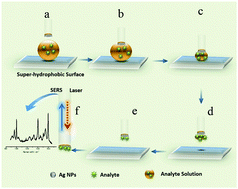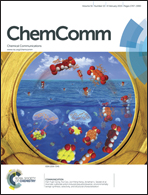SERS optrode as a “fishing rod” to direct pre-concentrate analytes from superhydrophobic surfaces†
Abstract
SERS optrodes were used to “fish” aqueous drops from superhydrophobic surfaces. The technique led to an improvement of 2–3 orders of magnitude in the lowest detectable amount of the Raman probe nile blue A, reaching 25 fg (34 attomoles). Further tests run on samples containing pesticide revealed that 20 pg of triazophos could be clearly detected from a single drop.


 Please wait while we load your content...
Please wait while we load your content...